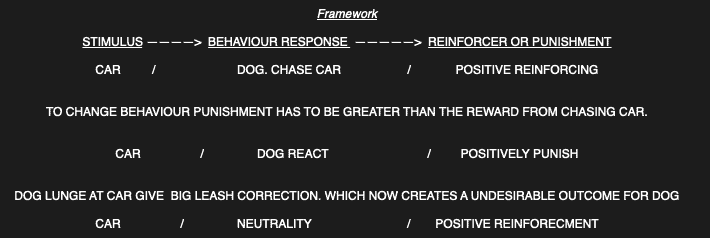How dogs learn
Reinforcement : Something that Increases the frequency of a behaviour
Punishment : Something that decreases the frequency of a behaviour
Postive ( + ) : Add
Negative ( – ) : Take away
POSITIVE REINFORCEMENT: Something is ADDED to INCREASE the frequency of a behaviour.
(Ex. Treats, Toys, Play , praise, etc)
Your dog decides what’s positive reinforcing GOOD OR BAD NOT YOU , its up to you to find out what’s positive reinforcing to your dog .
(Ex. Other dogs, people, environment, squirrels)
PROS OF POSITIVE REINFORCEMENT : where all the teaching happens
CONS OF POSITIVE REINFORCEMENT : Limited Motivation/ desire , Run into competitive motivators ( Ex.Other dogs, environment, wild life etc )
NEGATIVE REINFORCEMENT: Something is REMOVED to INCREASE the frequency of a behaviour.
( Ex. Lease Pressure aka Physical Pressure, Voice pressure, spacial pressure etc)
Discomfort to comfort ( Ex. When dog feels leash pressure aka discomfort it will do Desired action to feel comfort. This is best used after desired action is learned through positive reinforcement than add negative reinforcement to build OBLIGATION.
PROS OF NEGATIVE REINFORCEMENT : Build obligation
CONS OF NEGATIVE REINFORCEMENT : If you train only using – reinforcement you’ll have a compliant dog that lacks motivation and or doesn’t want to work.
EVERYTHING LOOPS BACK TO POSITIVE REINFORCEMENT THIS IS WHERE THE DOG LEARNS
POSITIVE PUNISHMENT : Is something that’s ADDED to DECREASE the frequency of a behavior
( Ex. Leash pressure, verbal pressure spacial pressure )
PROS OF POSITIVE PUNISHMENT : Remove behaviours
CONS OF POSITIVE PUNISHMENT : You can’t teach anything
Negative reinforcement and Positive Pressure are the same ill explain
Perception is different for every dog. Perception is important because it determines the level of pressure the dog receives from a correction. Light leash correction will often be perceived as a negative reinforcement but there’s a threshold where the dog no longer feels uncomfortable but very undesirable. ( Negative reinforcement to Positive Punishment)
NEGATIVE PUNISHMENT : Something is TAKEN AWAY to decrease the frequency of behaviour.
(Ex. Withholding a item dog desires.)
PROS OF NEGATIVE PUNISHMENT : You can remove behaviours
CONS OF NEGATIVE PUNISHMENT : Limited to dogs desire & can’t teach
YOU FILL THE VOID WITH A PRODUCTIVE BEHAVIOUR RESPONSE LIKE NEUTRALITY OR NOT LOOKING AT CAR ETC WHICH IS REINFORCED WITH FOOD PRAISE AFFECTION .
YOU MUST PUNISH THE BEHAVIOUR AND THEN FILL IT WITH SOMETHING MORE DESIRABLE FOLLOWED WITH POSITIVE REINFORCEMENT .

Dogs acquire knowledge of their names through a technique known as classical conditioning. This occurs when we consistently use their name while engaging in actions such as petting them, providing food or treats, summoning them, or lavishing them with attention.
An average canine can comprehend approximately 165 words, which includes both verbal cues and signals. On the other hand, the most intelligent dogs, commonly referred to as “super dogs,” have the capacity to learn up to 250 words.
Dogs benefits from sniffing another dog’s behind by receiving a chemical message that conveys details about the other dog’s diet, emotions, and gender. These messages are encoded in the scent and are transmitted through the glands located in the anal sacs on each side of a dog’s rear end.
Most puppies will typically develop the ability to bark by the time they reach eight weeks of age. During playtime with their littermates, they will often express themselves through barking. However, there is no need to be concerned if your puppy does not bark. While some puppies may begin barking later than others, there are also those who may never develop this behavior. It is perfectly normal for a puppy to grow up without ever starting to bark.

